Page 720 - My FlipBook
P. 720
718 ORTIIODOyriA as an OrKRATIVE PROCEDURE.
bent, and tlie spring sliortencd and forced to place ii])on the teeth. The
Fig. G47.
Fig. 648.
Crib, spring, and band (Jackson) Bar, band, and screw.
little spring acts in two directions—first, to carry the teeth laterally
and thus provide room ; secondly, to draw the irregular teeth into
position. In the hands of the writer this has been a very efficient
appliance.
Fig. 649.
German-silver spring (Talbot).
Making Room.—If the adjacent teeth overlap the one out of posi-
tion it is best to make room before attempting to move it, because it
cannot advance until room is made for it, and force spent on it will be
of no avail unless the tooth acts as a wedge to force the others a]:)art.
A piece of compressed wood, one of the oldest forces used in ortho-
dontia, can be used in many cases as shown at a, Fig. 650. Cut a piece
of wood about a third larger than the space, compress it with pliers or
the vise, and insert it with the grain parallel to the axis of the teeth.
If the sides are made slightly concave, it will hold in place better. As
the w^ood absorbs moisture it will swell and press the teeth apart.


